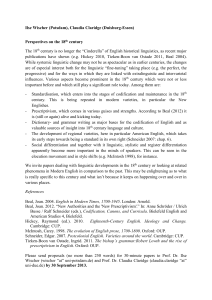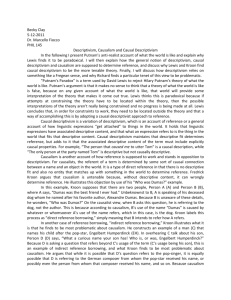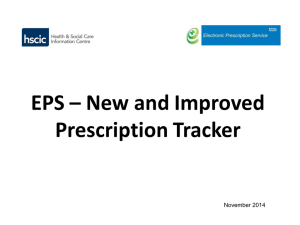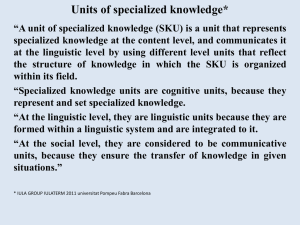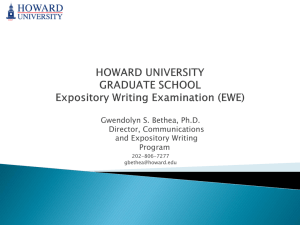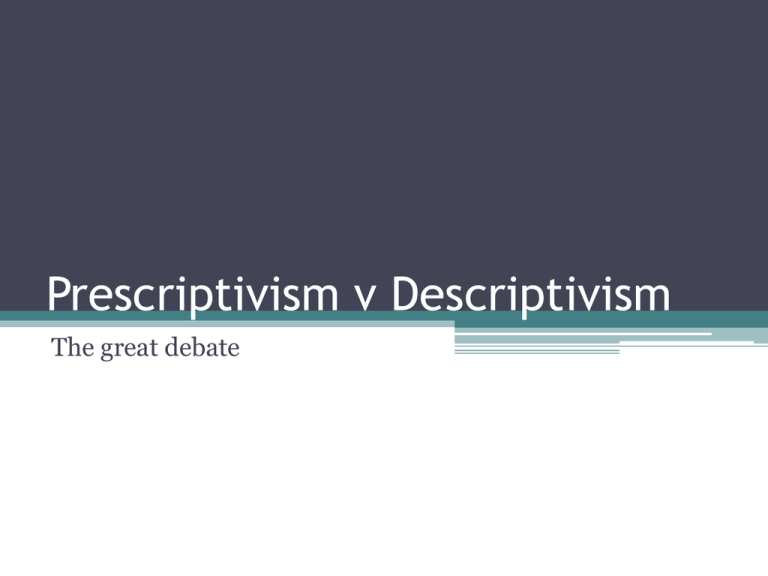
Prescriptivism v Descriptivism
The great debate
What is prescriptivism?
• In relation to linguistics this is one of the most basic
notions that you must become familiar with.
• It is the school of thought that concerns itself with
how language in particular spelling, grammar,
pronunciation and syntax.
• It determines what is socially proper and politically
correct.
• It also aids standardisation in that it helps to
develop a universal means of communication.
• Most people would agree that in all of these areas it
is meaningful to describe some usages as, at least,
inappropriate in particular contexts. One main aim
of prescription is to draw workable guidelines for
language users seeking advice in such matters.
•
"A prescriptive grammar is essentially a manual
that focuses on constructions where usage is
divided, and lays down rules governing the socially
correct use of language. These grammars were a
formative influence on language attitudes in Europe
and America during the 18th and 19th centuries.
Their influence lives on in the handbooks of usage
widely found today, such as A Dictionary of Modern
English Usage (1926) by Henry Watson Fowler
(1858-1933), though such books include
recommendations about the use of pronunciation,
spelling, and vocabulary as well as grammar."
(David Crystal, How Language Works. Overlook
Press, 2005)
Historically
• It dates back to Ancient civilisations who used orthography to
implement a widespread standard means of communication.
(as we saw at the beginning of our unit)
• Prescriptivism was used to establish social stratification
(formation of groups) and social hierarchy.
• It was seen specifically through out the government, the
church and the military. Going back in history the majority of
people were not educated nor did they know how to write.
Their communication relied on a common tongue.
Prescriptivism helped to distinguish and separate from this
common tongue into a highly thought of standard language.
• The result of this has caused diglossia in which speakers
choose not speak a dialect that linguistically indicates lower
class or prestige.
NOW:
• Prescriptivism approach is still prevalent in society in
terms of beliefs, values and opinions. ‘The way you
should speak!!’ ‘That’s not proper English’
• The most common prevalence of prescriptivism is seen
in schools. Text books on linguistics, grammar and
spelling, all indicate how one should write and speak.
The dictionary refers to the grammatical usages and
often gives examples to highlight this. Rules and
regulations in how we speak and write can be said to
stem from how and what we are taught.
• Swear words: what is and is not linguistically acceptable
when it comes to swearing.
• What constitutes good taste? Attitudes towards
products, regions, communities, genders and ethnicities.
Political and Ideological Aims?
• A complementary aim of linguistic prescription
is said to be the imposition of a political
ideology.
• Linguistic rules that determine Political
Correctness. Ideas and rules that relate to how
we use language to navigate issues on sex, race,
gender and discrimination
PROBLEMATIC?
• Prescription has a tendency to favour the language
of one particular region or social class over others,
and thus militates against linguistic diversity. The
standard variety can often be associated with the
upper class and can have clear political and social
consequences.
• Prescriptive rules quickly become entrenched and it
is difficult to change them when the language
changes. Thus there is a tendency for prescription to
be excessively conservative. As these rules are rigid
and conservative, prescription can be considered
antithetical (hostile) towards natural linguistic
evolution.
Problematic?
• Inappropriate dogmatism. While competent
authorities tend to make careful statements,
popular pronouncements on language are apt to
condemn. For instance the “correct” use of
language in schools can often create this stigma
that non standard varieties of English of
substandard or inferior. This is not the case and
can cause inequalities in society.
• Eg Australian English v Australian Aboriginal
English
In opposition?
• Descriptivism! But we will speak more about this
next lesson!!
• In the mean time:
• Read the 3 articles I have given you concerning
prescriptivism and descriptivism. What are the
main ideas being posed here.
Descriptivism
• This challenges prescriptivism as it focuses not on
what we should be saying, but how we actually
speak.
• It aims to observe the linguistic world as it is
without the linguistic bias affecting these
observations.
• Descriptive grammarians ask the question, “What is
English (or another language) like — what are its
forms and how do they function in various
situations?” By contrast, prescriptive grammarians
ask “What shouldEnglish be like — what forms
should people use and what functions should they
serve?”
What subsystems can we relate this
to?
• A description of the phonology of the language
in question.
• A description of the morphology of words
belonging to that language.
• A description of the syntax of well-formed
sentences of that language.
• A description of spelling in variations of english
• A description of lexical derivations.
What does it rely on?
• Context!
• When, where and what is being spoken. What
types of language being used and what implied
meanings can we interpret from these words,
expression and sentences.
Problems?
• Text can be interpreted any which way. If we constantly read
the meaning, misinterpretations can occur. Just like when you
send a text and it is misinterpreted by the other person.
• Spoken language is very different from written language. If we
wrote how we spoke half the time the meaning would be lost
and confusion may occur. If you were to record a conversation
you had with 5-6 mates, most likely many would find the
written version quite confusing as it lacks context, prosodic
indications and paralinguistic features.
• WHO DECIDES WHAT IS RIGHT? If we don’t have a so
called authority on language, then mispronunciations,
misspellings, incorrect information flow. If everyone did not
adopt a uniform approach then many variations would occur.
• Subsequently the predicament of trying to understand others
would become even more difficult.
A one way approach?
• To what extent are both opinions correct?
• Should there be a one sided approach?
• Do you think English today is a hybrid of the
two? WHY?
http://www.youtube.com/watch?v=J7EaoXLZGY&feature=player_embedded

